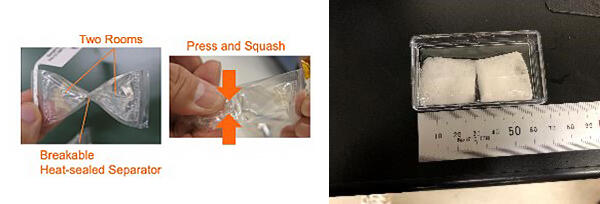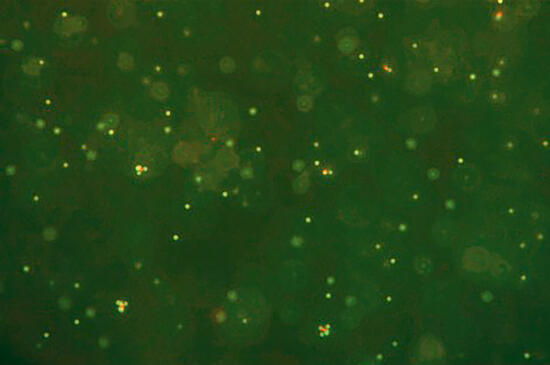The research group, composed of Professor Junpei Yamanaka, Associate Professor Tohru Okuzono, Assistant Professor Akiko Toyotama, and numerous graduate and undergraduate students of the Graduate School of Pharmaceutical Sciences Physical Chemistry of Colloid and Polymer Group of Nagoya City University, in collaboration with Professor Tsunehiko Higuchi of the Graduate School of Pharmaceutical Sciences Bioorganic-inorganic Chemistry Group of Nagoya City University, Dr. Jitendra Mata of the Australian Nuclear Science and Technology Organization, JAXA, Japan Space Forum (JSF), Japan Manned Space Systems Corporation, and Advanced Engineering Services, has been conducting research since July 2019 at the Japanese Experiment Module "Kibo" situated on the International Space Station (ISS), on the theme adopted by JAXA: the association and aggregation of colloidal fine particles.

(Provided by Nagoya City University/JAXA)
The group succeeded in creating clusters of positively and negatively charged particles and analyzed the gel-fixed sample to confirm the generation of clusters of high-density particles that are difficult to synthesize terrestrially. A small number of atomic/molecular clusters are widely observed in nature, from the initial process of crystal growth to the formation of protein complexes in cells. In this study, a cluster approximately 1 μm in size was formed by the spontaneous assembly of colloidal particles in water in a micro-gravity environment. The clusters were assembled by Coulombic forces by using positively and negatively charged particles.

(Provided by Nagoya City University/JAXA). The long side of the photo is 80 micrometers.
Colloidal clusters are expected to be useful as materials in the optical field. However, materials having a high refractive index are required for optical applications. Since high refractive index materials usually have high specific gravities, the influence of sedimentation is significant on Earth, but accurate experiments cannot be performed. Therefore, the micro-gravity environment of the ISS becomes advantageous.
In the experiment, positively and negatively charged particles of approximately 1 μm size were dispersed in water in a micro-gravity environment by astronauts to form a cluster. Thereafter, the entire sample was fixed using a polymer gel and transported to the ground, and nearly 30 samples that arrived in Nagoya City University in March this year have been analyzed. The analysis results confirmed the formation of clusters of high-density titania particles.

(Provided by Nagoya City University/JAXA).
In the future, the group will conduct a more detailed analysis to clarify the effects of microgravity on the association of particles. The research results are expected to be utilized for the fabrication of novel materials and biosensors that trap light and for the elucidation of agglutination phenomena in vivo. According to Professor Yamanaka, "We attempted to create clusters of colloidal particles and searched for conditions under which the particles could be assembled and fixed in gel after a long period of time. Although cluster formation experiments are difficult to perform on the ground, samples fabricated in space are homogeneous and do not suffer from sedimentation. In the future, we will investigate the relation between the number of associations and the shape of titania particle clusters by microscopic observation. Based on the understanding derived from the experiments, we would like to utilize colloidal crystals as optical materials such as photonic crystals in the future."
■ Photonic crystal: A structure whose refractive index changes periodically in the order of the wavelength of light (400-800 nanometers for visible light). The transmission of light inside the crystal can be controlled by altering the structure of the crystal.
This article has been translated by JST with permission from The Science News Ltd.(https://sci-news.co.jp/). Unauthorized reproduction of the article and photographs is prohibited.




